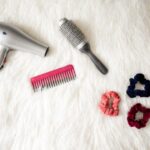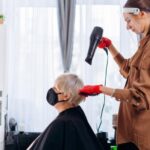Ionic hair dryers use negative ions to break down water molecules, resulting in faster drying times and healthier hair. Their benefits include reduced frizz, increased shine, and protection from heat damage. Proper maintenance and care can help ensure optimal performance and a longer lifespan for your hair dryer.

The Science Behind Ionic Hair Dryer Technology
Ionic hair dryers leverage the power of negative ions to break down water molecules on the hair shaft, allowing for faster drying times and less heat damage. These negative ions help to neutralize the positive charge of the hair, which results in smoother, shinier, and frizz-free hair.
Table: The Science Behind Ionic Technology
| Aspect | Description |
|---|---|
| Negative Ions | Electrically charged particles with a surplus of electrons |
| Hair Charge | Positively charged due to water molecules |
| Ionic Interaction | Negative ions neutralize the positive charge of the hair, reducing frizz and static |
“Ionic hair dryers use negative ions to neutralize the positive charge of the hair, resulting in smoother, shinier, and frizz-free hair.”
Benefits of Negative Ions in Hair Drying
Negative ions generated by ionic hair dryers offer numerous benefits, including reduced drying time, minimized heat damage, and improved hair health. Additionally, ionic technology can help to smooth the hair cuticle, leading to shinier and more manageable hair.
Table: Benefits of Negative Ions in Hair Drying
| Benefit | Description |
|---|---|
| Reduced Drying Time | Breaks down water molecules for faster evaporation |
| Minimized Heat Damage | Less time under heat reduces the risk of damage |
| Improved Hair Health | Smoother cuticle results in shinier, more manageable hair |
The Science Behind Ionic Hair Dryer Technology
Ionic hair dryers leverage the power of negative ions to break down water molecules on the hair shaft, allowing for faster drying times and less heat damage. These negative ions help to neutralize the positive charge of the hair, which results in smoother, shinier, and frizz-free hair.
What Are Negative Ions?
Negative ions are electrically charged particles with a surplus of electrons. In the context of hair dryers, these ions are generated by an internal component, such as a ceramic or tourmaline heating element, and then released into the airstream.
The Interaction Between Ions and Hair
Hair typically carries a positive charge due to the presence of water molecules. When negative ions come into contact with the hair, they neutralize the positive charge, reducing static and frizz. This process also helps to break down water molecules on the hair shaft, allowing them to evaporate more quickly, which speeds up the drying process.
Benefits of Negative Ions in Hair Drying
Negative ions generated by ionic hair dryers offer numerous benefits, including reduced drying time, minimized heat damage, and improved hair health. Additionally, ionic technology can help to smooth the hair cuticle, leading to shinier and more manageable hair.
Reduced Drying Time
The interaction between negative ions and water molecules allows for faster evaporation, reducing the overall drying time. This means less time spent exposing your hair to heat, which can help to minimize the risk of heat damage.
Minimized Heat Damage
Since ionic hair dryers speed up the drying process, your hair is exposed to heat for a shorter duration. This can help to minimize heat damage and preserve the overall health of your hair.
Improved Hair Health
Ionic hair dryers can lead to smoother hair cuticles, which results in shinier, more manageable hair. By neutralizing the positive charge of the hair, negative ions help to reduce frizz and static, making your hair easier to style and maintain.
How Ionic Hair Dryers Generate Ions
Ionic hair dryers generate negative ions through their internal components, typically using either ceramic or tourmaline materials. The choice of material can influence the amount of negative ions produced and the overall performance of the hair dryer.
Ceramic Ionic Hair Dryers
Ceramic is a popular material used in hair dryers for its even heat distribution and ability to generate negative ions. When heated, ceramic components emit negative ions into the airstream, which then interact with the hair to provide the benefits previously discussed.
Tourmaline Ionic Hair Dryers
Tourmaline is a crystalline mineral that, when heated, produces a significant amount of negative ions. Hair dryers that feature tourmaline components are often more effective at generating ions than their ceramic counterparts. This can result in even faster drying times and greater benefits for the hair.
Table: Ionic Hair Dryer Components
| Component | Description |
|---|---|
| Ceramic | Even heat distribution, generates negative ions when heated |
| Tourmaline | Crystalline mineral, produces a higher amount of negative ions when heated |
“Ionic hair dryers generate negative ions through ceramic or tourmaline components, with tourmaline producing a higher amount of ions for greater hair benefits.”
Comparing Ionic and Non-Ionic Hair Dryers
Both ionic and non-ionic hair dryers can dry your hair, but they differ in the technologies used and the benefits they offer. Understanding the differences between the two can help you make an informed decision about which type is best for your needs.
Ionic Hair Dryers
As previously discussed, ionic hair dryers use negative ions to break down water molecules on the hair shaft, allowing for faster drying times and less heat damage. They also help to smooth the hair cuticle, resulting in shinier and more manageable hair.
Non-Ionic Hair Dryers
Non-ionic hair dryers do not generate negative ions and, as a result, do not offer the same benefits as ionic hair dryers. They may take longer to dry your hair, which can lead to more heat exposure and a higher risk of heat damage. Non-ionic hair dryers may also be less effective at reducing frizz and static.
Table: Comparing Ionic and Non-Ionic Hair Dryers
| Type | Benefits |
|---|---|
| Ionic | Faster drying times, less heat damage, smoother and shinier hair |
| Non-Ionic | Longer drying times, higher risk of heat damage, less effective at reducing frizz and static |
“Ionic hair dryers offer faster drying times, less heat damage, and smoother, shinier hair compared to non-ionic hair dryers.”
Ionic Hair Dryer Maintenance and Care
To ensure your ionic hair dryer continues to perform effectively and has a long lifespan, it’s essential to maintain and care for it properly. Here are some tips for keeping your ionic hair dryer in good working condition:
Clean the Air Filter
The air filter on your hair dryer is designed to prevent dust and debris from entering the dryer’s motor. Over time, the filter can become clogged, which can reduce the hair dryer’s performance and potentially damage the motor. Make a habit of cleaning the filter regularly by removing it from the dryer and gently brushing away any dust or debris. Some hair dryers have washable filters that can be rinsed with water for a more thorough cleaning.
Store Properly
When not in use, store your hair dryer in a cool, dry place away from direct sunlight or sources of moisture. Avoid wrapping the cord tightly around the hair dryer, as this can cause damage to the cord over time. Instead, gently coil the cord and secure it with a twist tie or rubber band.
Handle with Care
Ionic hair dryers can be more delicate than traditional hair dryers due to the ceramic or tourmaline components. Handle your hair dryer with care to avoid dropping it or causing damage to the internal components. If your hair dryer does sustain damage, it may be more cost-effective to replace it rather than attempting a repair.
Table: Ionic Hair Dryer Maintenance Tips
| Maintenance Task | Importance |
|---|---|
| Clean the air filter | Prevents dust and debris from entering the motor, maintains performance |
| Store properly | Protects from damage, extends the lifespan of the hair dryer |
| Handle with care | Prevents damage to delicate internal components |
Evaluating Ionic Hair Dryer Performance
When choosing an ionic hair dryer, it’s important to evaluate its performance based on several factors, including the amount of ions generated, drying time, and the overall hair benefits experienced. Here are some tips for evaluating ionic hair dryer performance:
Read Reviews
Online reviews can provide valuable insights into the real-world performance of a hair dryer. Look for reviews that specifically discuss the ionic features of the hair dryer and the results they have achieved.
Consult a Professional
Hair stylists and other professionals are likely to have experience with a variety of hair dryers and can provide recommendations based on their own experiences. They may also be able to offer advice on which features are most important for your specific hair type and needs.
Test the Hair Dryer
If possible, test the hair dryer before making a purchase. This can give you a better sense of the weight, balance, and overall performance of the hair dryer. Pay attention to factors like the speed of drying, the smoothness of your hair, and any reduction in frizz or static.
Conclusion
Ionic hair dryers harness the power of negative ions to offer numerous benefits, including faster drying times, reduced frizz, and smoother, shinier hair. Understanding the science behind ionic hair dryer technology, the benefits of negative ions, and how these hair dryers generate ions can help you make an informed decision when selecting the best hair dryer for your needs. By comparing ionic and non-ionic hair dryers, maintaining and caring for your hair dryer, and evaluating its performance, you can ensure you get the most out of this innovative hair care tool.
Key Takeaways
- Ionic hair dryers use negative ions to break down water molecules on the hair shaft, resulting in faster drying times and healthier hair.
- Benefits of ionic hair dryers include reduced frizz, increased shine, and protection from heat damage.
- Proper maintenance and care, such as cleaning the air filter and handling the hair dryer with care, can extend the lifespan of your ionic hair dryer.
- Evaluating ionic hair dryer performance involves reading reviews, consulting professionals, and testing the hair dryer to ensure it meets your needs and expectations.








